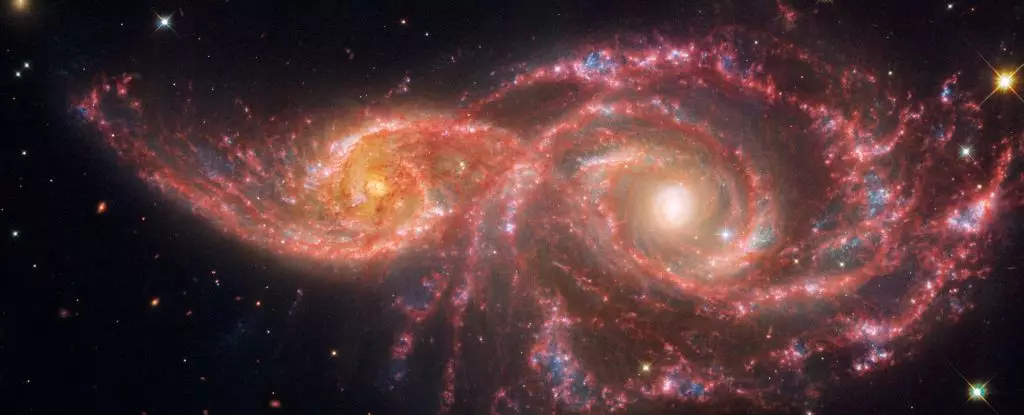The philosophical musings of Friedrich Nietzsche echo across the corridors of centuries, particularly when we contextualize them within modern astrophysics. His assertion that “if you gaze for long into an abyss, the abyss gazes also into you” serves as a profound reminder of our intricate relationship with the cosmos. This realization is starkly illuminated by a recent visual captured by the Hubble and James Webb Space Telescopes (JWST), showcasing the tandem collision of galaxies NGC 2207 and IC 2163—two colossal structures merging in an elaborate cosmic ballet over 80 million light-years away. In this unbelievable space-time narrative, we are drawn into a spectacle that inspires awe, compelling us to ponder our place in the universe.
The process of galaxy merging is a slow and complex event, not simply characterized by explosive collisions but rather a drawn-out interaction marked by gravitational influences. These two galaxies continue their mysterious waltz, having previously brushed against one another millions of years ago. When examining their current dance, it is evident that the merger is still in its nascent stages; NGC 2207 and IC 2163 maintain their distinct spiral forms. However, the gravitational pull they exert on one another cannot be understated, as it ignites a brewing frenzy of star formation within their gaseous components.
As these spirals approach each other, they induce a compression of the interstellar material, giving rise to the birth of countless stars in an ongoing feedback loop of construction and destruction. Each galaxy currently generates numerous stars equivalent to multiple solar masses every year—astonishingly contrasted with our relatively calm Milky Way, which only forges a handful of new stars in the same timeframe. This stark difference highlights not only the vigor of such mergers but also underscores the unique evolutionary paths galaxies can undertake.
The Lifecycle of Stars: Birth, Death, and Rebirth
The phenomenon of star formation within colliding galaxies is complemented by the lifecycle of the stars themselves. Massive stars that erupt in these nebulous regions have drastically shorter lifespans compared to their lesser counterparts. Upon reaching the end of their life cycles, they often undergo catastrophic explosions known as supernovae. This dramatic event not only marks the end of a star’s existence but also reverberates throughout its surroundings. The energetic release from a supernova can induce further compression of nearby gas clouds, fueling additional star formation—a riveting cycle of cosmic creation.
The contrasting hues present in images captured by the Hubble and JWST lend themselves to discovery, as seen in the vibrant blue regions symbolizing newborn stars—a telltale signature of intense star-forming activity—while the JWST intricately maps the filamentary patterns of cosmic dust nestled within the galaxies. This duality of formation and destruction reveals not just a chaotic violence but a nuanced, intricate balance integral to the cosmic ecology.
While Nietzsche’s contemplation calls upon us to recognize the dual nature of gazing into the abyss, our current observations of galaxy collisions take this notion to its extreme. As we probe deeper into space, probing the interactions of massive celestial bodies, we are not simply witnesses to cosmic cataclysms but participants in a vast narrative where each new discovery calls into question our significance in the greater cosmos.
Perhaps, then, we need to adapt Nietzsche’s words to mirror our ongoing exploration: “And sometimes, perhaps, you get a glimpse into the fascinating alien workings of something so much more vast and more ancient than your tiny, insignificant little self.” This humbling realization can inspire us to cultivate a greater appreciation for the natural universe, as each image of destruction births the possibility of creation, reminding us of the delicate interplay between chaos and structure within the cosmic fabric.
Ultimately, the collision of NGC 2207 and IC 2163 serves as a metaphor for our own existence—an intricate dance marked by both creation and destruction, constantly evolving towards a future that remains nebulous. By observing these astronomical phenomena, we glean insight not just into the cosmos but into ourselves, prompting a profound reflection on our role within the expansive universe. Every gaze into the abyss not only reveals the vastness of space but also invites a deeper understanding of our interconnectedness with the infinite cosmos.


Leave a Reply